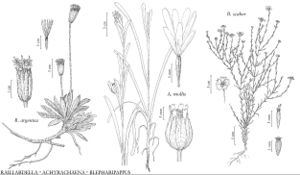Difference between revisions of "Raillardella argentea"
in W. H. Brewer et al., Bot. California 1: 417. 1876.
IllustratedEndemic
Basionym: Railliardia argentea A. Gray Proc. Amer. Acad. Arts 6: 550. 1865 (as Raillardia)
Treatment appears in FNA Volume 21. Treatment on page 257.
imported>Volume Importer |
imported>Volume Importer |
||
| Line 1: | Line 1: | ||
{{Treatment/ID | {{Treatment/ID | ||
|accepted_name=Raillardella argentea | |accepted_name=Raillardella argentea | ||
| − | |accepted_authority=(A. Gray) A. Gray | + | |accepted_authority=(A. Gray) A. Gray |
|publications={{Treatment/Publication | |publications={{Treatment/Publication | ||
|title=in W. H. Brewer et al., Bot. California | |title=in W. H. Brewer et al., Bot. California | ||
| Line 45: | Line 45: | ||
-->{{#Taxon: | -->{{#Taxon: | ||
name=Raillardella argentea | name=Raillardella argentea | ||
| − | |authority=(A. Gray) A. Gray | + | |authority=(A. Gray) A. Gray |
|rank=species | |rank=species | ||
|parent rank=genus | |parent rank=genus | ||
| Line 59: | Line 59: | ||
|publication year=1876 | |publication year=1876 | ||
|special status=Illustrated;Endemic | |special status=Illustrated;Endemic | ||
| − | |source xml=https:// | + | |source xml=https://bitbucket.org/aafc-mbb/fna-data-curation/src/2e0870ddd59836b60bcf96646a41e87ea5a5943a/coarse_grained_fna_xml/V19-20-21/V21_633.xml |
|tribe=Asteraceae tribe Heliantheae | |tribe=Asteraceae tribe Heliantheae | ||
|subtribe=Asteraceae (tribe Heliantheae) subtribe Madiinae | |subtribe=Asteraceae (tribe Heliantheae) subtribe Madiinae | ||
Latest revision as of 20:13, 5 November 2020
Plants 1–15 cm. Leaf blades oblanceolate, margins entire or toothed, faces sericeous (silvery), sometimes sparsely stipitate-glandular as well. Ray florets 0. Disc florets 7–26; corollas yellow, 6–11 mm. 2n = 34, 36.
Phenology: Flowering Jul–Sep.
Habitat: Dry, exposed, often gravelly sites
Elevation: 1800–3900 m
Distribution

Calif., Nev., Oreg.
Discussion
Raillardella argentea occurs widely in the Sierra Nevada and southern Cascade Range and locally in the Klamath Ranges, San Bernardino Mountains (Mt. San Gorgonio), and western ranges of the Great Basin. Artificial hybrids with R. pringlei are completely fertile and vigorous (D. W. Kyhos et al. 1990); the two species are not known to co-occur in nature.
Selected References
None.
Lower Taxa
None.
